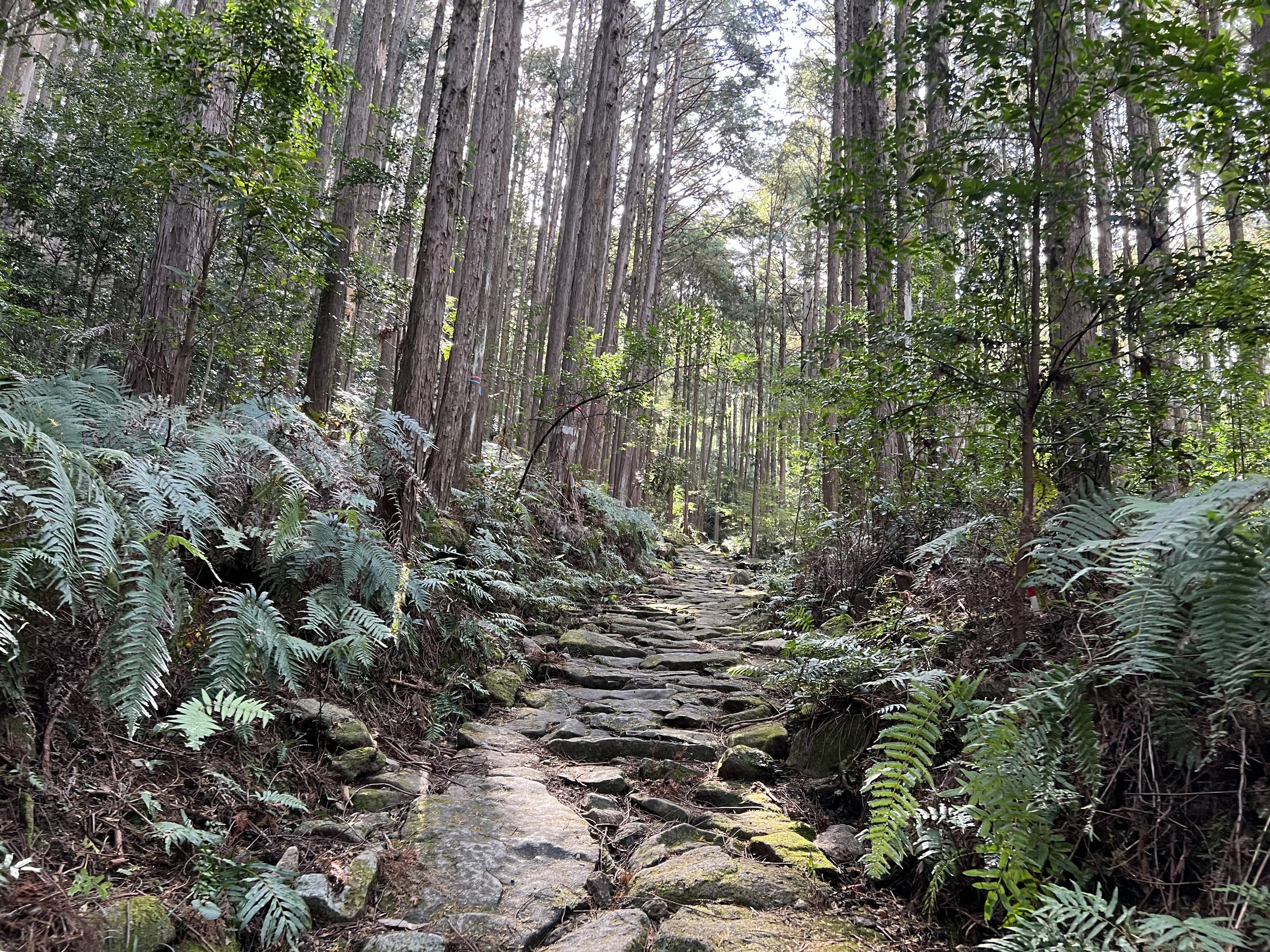Magose-toge Pass Hiking Guide: A Quiet Kumano Kodo Experience in Mie
Located in the mountains of Mie Prefecture, near Owase, the Magose-toge Pass trail is a historic stone-paved path that leads you through ancient cypress forests and offers panoramic viewpoints along the way. I hiked it during my one-week road trip through Mie and Wakayama Prefectures and was struck by how peaceful it was.
If you’re in for a beautiful, manageable half-day hike, perfect for appreciating off-the-beaten-path Japan while getting some exercise on a quiet nature trail, then the Magose-toge Pass might be just what you’re looking for. In this guide, I’ll walk you through everything you need to know to plan your visit and make the most of the trail.
What is the Kumano Kodo Iseji Route ?
The Iseji Route is one of the four main pilgrimage routes that make up the Kumano Kodo, a UNESCO World Heritage network of ancient trails. Stretching around 170 kilometers, the Iseji Route connects the sacred Ise Jingu Shrine in Mie Prefecture to the revered Kumano Sanzan shrines in Wakayama. Unlike the more mountainous Nakahechi Route, the Iseji path traces the east coast of the Kii Peninsula, where you can encounter terraced rice fields, bamboo and cypress forests, and quiet beaches along the way.
About the Magose-toge Pass Trail
The Magose-toge Pass (馬越峠) is one of the best-preserved sections of the Kumano Kodo Iseji pilgrimage route in Mie Prefecture and one of the most atmospheric trails I’ve hiked in Japan. This short section includes around 2 kilometers of beautifully preserved cobblestone path, climbing through a dense cypress forest that feels straight out of a Ghibli film. The full hike is about 4 to 5 kilometers long and takes 2 to 3 hours depending on your pace. It’s a peaceful, off-the-beaten-path walk that gives you a real sense of what ancient pilgrims might have felt as they made their way toward the sacred sites of Kumano.
How to Get to the Start of the Hike
The easiest and most flexible way to reach the Magose-toge Pass is by car, especially if you’re road-tripping through Mie or the Kumano region.
You can park for free at the Michi-no-Eki Miyama (Miyama Roadside Station), which is located just a few minutes walk from the trailhead.
There is a small information center where you can pick up a map of the trail, toilets, a restaurant. I’d also recommend to check out the small souvenir shop to find fresh produce, regional snacks, and souvenirs.
If you're relying on public transportation, it’s also possible to get there by train and bus, though it requires a bit more planning.
Take the JR Kisei Line and get off at either Owase Station or Aiga Station.
From there, you can take a taxi or a local bus to the Washige Bus Stop, which is within walking distance of Miyama Roadside Station and the Magose Toge trail entrance. If you choose to stop at Aiga station, you can also walk for 30 minutes to the start of the trail.
✨ TRAVELY TIP: Trains and buses in this area are relatively infrequent, so be sure to check the latest timetables in advance. I liked using Google maps as I found it generally accurate, but you can also use apps and websites like NAVITIME or Japan Transit Planner by Jorudan that can help with schedules and route planning.
Hike the Magose Toge Pass with Me
Once you’re ready to start, just follow the sidewalk from Miyama Roadside Station, you’ll quickly spot signs pointing you toward the Magose-toge Pass. On Google Maps, look for: Kumano Kodo Iseji Magose Pass climbing entrance (熊野古道 伊勢路 馬越峠 登り口). The trailhead is clearly marked with a large sign (pic below), making it hard to miss. It's a short walk from the parking lot, and right away, you’ll feel like you’re stepping into another world.
The trail begins with a gentle incline before turning into a long steep hill, and into a well-preserved stone-paved path laid centuries ago. Lined with towering cypress trees, the atmosphere becomes quiet and meditative. I passed only a few other walkers on my visit (plus a class of local high school students) making it feel like I had this ancient trail all to myself.
Along the way, you’ll find Jizo statues, mossy rocks, and occasional signposts. There are a few wooden benches to take breaks and admire the peacefulness of the forest and views of the surrounding mountains.
Yonaki Jizo statue
When you reach the Magose-toge Pass (325 meters above sea level), there’s a small resting area where you can take a break and catch a glimpse of Owase through the trees, a peaceful reward after the steady climb.
If you’re up for a longer adventure, you can take a detour to Mount Tengurasan (522 meters), where a panoramic view of Owase Bay awaits. I wish I had known about this option before planning my visit. It adds about an hour to the hike, and since I had other plans that day, I had to skip it. But if you have the time, it sounds like a great extension to the hike.
After crossing the Magose-toge Pass, the trail begins its descent. Along the way, you’ll find a few spots to pause and soak in the scenery, including an observatory offering a stunning view of Owase and the bay beyond.
As you continue down, you’ll eventually pass by a local cemetery and start seeing residential houses, a quiet sign that your hike is nearing its end.
Before you finish, make sure to stop by Kongoji temple (金剛寺) and Owase Jinja shrine (尾鷲神社), a serene Shinto shrine known for its huge sacred camphor trees.
And that’s it for the Magose-toge Pass hike! Depending on how you’re traveling, you can either walk back to JR Owase Station or head to the nearest bus stop to return to Miyama Roadside Station if you parked there. If you’re coming back by bus, it’s useful to check bus times in advance to avoid long waits.
My Hiking and Travel Tips Before Doing This Hike
Difficulty of the Hike
This hike is relatively easy, with some steep sections but nothing too technical. The path is well-maintained, and the original stone paving adds to the charm but can be a bit uneven or slippery when wet, so good shoes are a must. It’s about 2–3 hours at a leisurely pace, perfect for a half-day adventure with time to stop for photos and rest. There are wooden signposts along the way so it’s easy to follow.
➡️ You can download the route map of the Magose-toge Pass made by Mie Prefecture. It includes additional sights that I didn’t cover in my article, so I’ll recommend you to check it out!
What to Wear and Bring
Wear comfortable hiking shoes with good grip, especially because the stones can be slippery when damp after a rainy day. You should also bring water, as there are no vending machines along the trail, and maybe a small snack or picnic to enjoy at the pass.
Other Things to See and Do in the Area
Though I didn’t visit them myself, here are some additional ideas of places to visit in Owase:
Kumano Kodo Center (熊野古道センター), a beautiful wooden structure that introduces the history and culture of the Kumano Kodo with exhibits, maps, and information. It’s free to visit.
Yumekodo Owase (夢古道おわせ), an onsen facility in a renovated school building, that seems like a nice idea for a post-hike soak, with the possibility to enjoy a lunch made with regional ingredients at a seafood restaurant on site. The onsen area is small, but it seems like a nice local experience to try. Public bath entrance costs ¥700.
Owase Fish Market Ototo (おわせお魚いちば おとと), where you can purchase sushi and sashimi from the market area and eat them in a food court area.
➡️ You can also check my other articles on Mie Prefecture to get ideas of things to see and do. As I still have a lot to write about this fantastic and lesser-known prefecture, don’t hesitate to subscribe to my monthly newsletter to be informed when my new articles are published.
Where to Stay Around
The night before my hike, I stayed at Yuga Iseshima, a lovely onsen ryokan tucked away in the peaceful Shima area. It was a perfect place to unwind with a soak in the large hot spring baths after a day of exploring, and the kaiseki dinner (with so many courses) was a real highlight! If you're planning a road trip or want to explore more of the coastal side of Mie, I can warmly recommend it.
There are also plenty of charming ryokan and guesthouses scattered along the Mie coastline, especially around towns like Shima and Kumano.
➡️ Search for accommodation options in Mie Prefecture on Booking.com or Agoda.
To Conclude
The hike over the Magose-toge Pass was one of my favorite moments of my trip to Mie and Wakayama.
The Magose-toge Pass is a great half-day hike for slow travelers, nature lovers or anyone curious to explore some of the Kumano Kodo trails.
I hope this guide will help you plan your visit and hope you’ll enjoy the trail and the peaceful corner of Japan that surrounds it.
Interested in discovering more fantastic hikes in Japan? You can read about all the hikes I’ve done in Japan and written about.
Found this article helpful? Buy me a coffee. 😊
Want to stay in touch? Subscribe to my monthly newsletter (with latest articles, updates, travel tips and more...) delivered straight to your inbox. 📩
Some of the links in this Magose Toge Pass Hiking Guide are affiliate links. At no extra cost to you, I may earn a small commission when you click on them and make a purchase. And if you do, thanks for your support! Purchasing through these links is a great way to support Travely Notes, as this helps with the costs of running my blog.





















